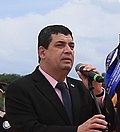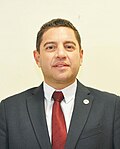| No. | Portrait | Name
(Birth–Death) | Term of office | Party | Election | President | Notes
|
|---|
| Start | End |
|---|
| 1 |  | Cayo Miltos
(1843–1871) | 25 November 1870 | 7 January 1871 | | — | 1870 | Cirilo Antonio Rivarola | Died in office. |
|---|
Vacant
7 January 1871 – 9 December 1871 | |
| 2 |  | Salvador Jovellanos
(1833–1881) | 9 December 1871 | 18 December 1871 | | — | — | Appointed by the Congress. Assumed the presidency after the resignation of Cirilo Antonio Rivarola. |
|---|
Vacant
18 December 1871 – 25 November 1874 | Salvador Jovellanos | |
| 3 |  | Higinio Uriarte
(1843–1909) | 25 November 1874 | 12 April 1877 | | — | 1874 | Juan Bautista Gill | Assumed the presidency after the assassination of Juan Bautista Gill. |
|---|
Vacant
12 April 1877 – 25 November 1878 | Higinio Uriarte | |
| 4 |  | Adolfo Saguier
(1832–1902) | 25 November 1878 | 4 September 1880 | | — | 1878 | Cándido Bareiro | Ousted from office by a coup d'état. |
|---|
Vacant
4 September 1880 – 25 November 1882 | Bernardino Caballero | |
| 5 |  | Juan Antonio Jara
(1845–1887) | 25 November 1882 | 25 November 1886 | | — | 1882 | |
|---|
| 6 |  | José del Rosario Miranda
(1832–1903) | 25 November 1886 | 25 November 1890 | | ANR–Colorado | 1886 | Patricio Escobar | |
|---|
| 7 |  | Marcos Morínigo
(1848–1901) | 25 November 1890 | 9 June 1894 | | ANR–Colorado | 1890 | Juan Gualberto González | Assumed the presidency after the forced resignation of Juan Gualberto González. |
|---|
Vacant
9 June 1894 – 25 November 1894 | Marcos Morínigo | |
| 8 |  | Facundo Ynsfrán
(1860–1902) | 25 November 1894 | 25 November 1898 | | ANR–Colorado | 1894 | Juan Bautista Egusquiza | |
|---|
| 9 |  | Andrés Héctor Carvallo
(1862–1934) | 25 November 1898 | 9 January 1902 | | ANR–Colorado | 1898 | Emilio Aceval | Assumed the presidency after the forced resignation of Emilio Aceval. |
|---|
Vacant
9 January 1902 – 25 November 1902 | Andrés Héctor Carvallo | |
| 10 |  | Manuel Domínguez
(1868–1935) | 25 November 1902 | 19 December 1904 | | ANR–Colorado | 1902 | Juan Antonio Escurra | Ousted from office by a coup d'état. |
|---|
Vacant
19 December 1904 – 25 November 1906 | Gaona | |
| Báez |
| 11 |  | Emiliano González Navero
(1861–1934) | 25 November 1906 | 4 July 1908 | | Liberal | 1906 | Benigno Ferreira | Assumed the presidency after Benigno Ferreira was deposed in a coup d'état. |
|---|
Vacant
4 July 1908 – 25 November 1910 | Emiliano González Navero | |
| 12 |  | Juan Bautista Gaona
(1845–1932) | 25 November 1910 | 17 January 1911 | | Liberal | 1910 | Manuel Gondra | Ousted from office by a coup d'état. |
|---|
Vacant
17 January 1911 – 15 August 1912 | Jara | |
| Rojas |
| Peña |
| González Navero |
| 13 |  | Pedro Bobadilla
(1858–?) | 15 August 1912 | 15 August 1916 | | Liberal | 1912 | Eduardo Schaerer | |
|---|
| 14 |  | José Pedro Montero
(1878–1927) | 15 August 1916 | 5 June 1919 | | Liberal | 1916 | Manuel Franco | Assumed the presidency after the death of Manuel Franco. |
|---|
Vacant
5 June 1919 – 15 August 1920 | José Pedro Montero | |
| 15 |  | Félix Paiva
(1877–1965) | 15 August 1920 | 29 October 1921 | | Liberal | 1920 | Manuel Gondra | Assumed the presidency after the resignation of Manuel Gondra. |
|---|
Vacant
29 October 1921 – 15 August 1924 | Paiva | |
| Eusebio Ayala |
| Eligio Ayala |
| Riart |
| 16 |  | Manuel Burgos
(1871–1947) | 15 August 1924 | 15 August 1928 | | Liberal | 1924 | Eligio Ayala | |
|---|
| 17 |  | Emiliano González Navero
(1861–1934) | 15 August 1928 | 25 October 1931 | | Liberal | 1928 | José Patricio Guggiari | Assumed the presidency after José Patricio Guggiari resigned to stand an impeachment. |
|---|
Vacant
25 October 1931 – 27 January 1932 | Emiliano González Navero | |
| 18 |  | Emiliano González Navero
(1861–1934) | 27 January 1932 | 15 August 1932 | | Liberal | — | José Patricio Guggiari | Restoration of its original mandate after José Patricio Guggiari was absolved from impeachment. |
|---|
| 19 |  | Raúl Casal Ribeiro
(1887–1952) | 15 August 1932 | 17 February 1936 | | Liberal | 1932 | Eusebio Ayala | Deposed after the Febrerista Revolution. |
|---|
Vacant
17 February 1936 – 15 August 1939 | Franco | |
| Paiva |
| 20 |  | Luis Alberto Riart
(1880–1953) | 15 August 1939 | 18 February 1940 | | Liberal | 1939 | José Félix Estigarribia | Ousted from office by a self-coup of José Félix Estigarribia. |
|---|
Vacant
18 February 1940 – 10 July 1940 | |
Post abolished
10 July 1940 – 15 August 1993 | | |
| Morínigo |
| Frutos |
| González |
| Rolón |
| López |
| Chaves |
| Pereira |
| Stroessner |
| Rodríguez |
| 21 | | Ángel Seifart
(1940–2018) | 15 August 1993 | 15 August 1998 | | ANR–Colorado | 1993 | Juan Carlos Wasmosy | |
|---|
| 22 |  | Luis María Argaña
(1932–1999) | 15 August 1998 | 23 March 1999 | | ANR–Colorado | 1998 | Raúl Cubas | Assassinated. |
|---|
Vacant
23 March 1999 – 2 September 2000 | |
| Luis Ángel González Macchi |
| 23 |  | Julio César Franco
(1951–) | 2 September 2000 | 16 October 2002 | | Authentic Radical Liberal | 2000 | Resigned to run for presidency. |
|---|
Vacant
16 October 2002 – 15 August 2003 | |
| 24 |  | Luis Alberto Castiglioni
(1962–) | 15 August 2003 | 4 October 2007 | | ANR–Colorado | 2003 | Nicanor Duarte | Resigned to run for presidency. |
|---|
Vacant
4 October 2007 – 21 November 2007 | |
| 25 |  | Francisco Oviedo
(1956–) | 21 November 2007 | 15 August 2008 | | ANR–Colorado | — | Appointed by the Congress. |
|---|
| 26 |  | Federico Franco
(1962–) | 15 August 2008 | 22 June 2012 | | Authentic Radical Liberal | 2008 | Fernando Lugo | Assumed the presidency after the impeachment of Fernando Lugo. |
|---|
Vacant
22 June 2012 – 27 June 2012 | Federico Franco | |
| 27 |  | Óscar Denis
(1946–) | 27 June 2012 | 15 August 2013 | | Authentic Radical Liberal | — | Appointed by the Congress. |
|---|
| 28 |  | Juan Afara
(1960–) | 15 August 2013 | 11 April 2018 | | ANR–Colorado | 2013 | Horacio Cartes | Resigned to run for senator. |
|---|
Vacant
11 April 2018 – 9 May 2018 | |
| 29 |  | Alicia Pucheta
(1950–) | 9 May 2018 | 15 August 2018 | | ANR–Colorado | — | Appointed by the Congress. |
|---|
| 30 |  | Hugo Velázquez
(1966–) | 15 August 2018 | 15 August 2023 | | ANR–Colorado | 2018 | Mario Abdo Benítez | |
|---|
| 31 |  | Pedro Alliana
(1974–) | 15 August 2023 | Incumbent | | ANR–Colorado | 2023 | Santiago Peña | |
|---|
|

































